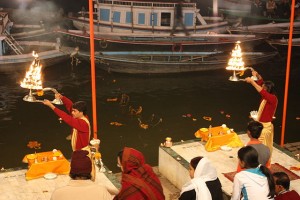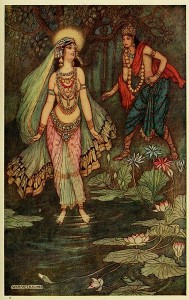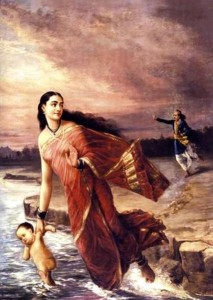There I was, trying to write a scene in my fictionalized biography of the Pandita Ramabai, and failing. At this point in the story, Rama is nine years old. It’s hard to write from a child’s perspective. The family is in Varanasi, the holiest city in India. Pilgrims and tourists daily arrive in great numbers. Pilgrims believe if they wash in the Ganges, they’ll be purified of all imperfections. Tourists believe all sorts of things.
I kept trying to think. Of all the sights I saw when I visited Varanasi, what would be the one most apt to catch the imagination of a nine-year-old girl? Then I remembered the Ganga Aarti – a religious ritual honoring the Goddess Ganga. It’s done at sunset on the shore of the her home, the Ganges River. I sat with other group members in a small boat at the bottom of the steps, looking at the platform where priests perform the ritual.

Photo by Arian Zwegers.
Creative Commons Attribution
Wikimedia Commons
The lamp wicks are soaked in ghee (clarified butter). Priests wave the lamps clockwise symbolizing how people’s daily activities revolve around the deity. If you want to watch the ceremony, there’s a good video by Kisho Bhattacharjee available on YouTube. http://www.youtube.com/watch?v=rLyYyDB_DpU
As is true for most gods, there are various stories about Goddess Ganga’s interactions with the world of men. What might be an appealing story for a young girl? Perhaps the one about Goddess Ganga and her consort King Shantanu. When the king asked for her hand in marriage, Ganga accepted with one condition. He could never contradict her. [Hmmmm. How come you never see that stipulation in marriage ceremonies?]

King Shantanu
Art by Donald Alexander Mackenzie, 1913
US Public Domain.
Wikimedia Commons
About that time, a sage named Vasishtha cursed the eight Astavasu brothers, because they’d stolen the divine cow, Nandini. Vasishtha decreed the Astavasus must be born on earth as humans, before they could return to heaven. There was one exception. The brother who instigated the theft would remain on earth longer. Reluctantly, the brothers set out for earth to fulfill the curse. On the way, they encountered the Ganga who agreed to become their mother on earth. Ganga bore her first son, and immediately drowned him. She did the same with the second. Shantanu could not make her stop, because he’d promised not to contradict her. He had to choose between Ganga and his children. Finally, as Ganga was poised to drown her eighth child, Shantanu intervened. Ganga was furious and disappeared with the surviving infant.

Art by Raja Ravi Varma
US Public Domain
Wikimedia Commons
Several years later, Ganga emerged from the river and gave her son to Shantanu. “This child,” she predicted, “will be a great hero.” He grew up to be Bhishma, a major player in the Mahabharata, a story for another post.
For more information:
Featured Image: Courtesy of http://www.flickr.com/photos/u-suke/ Originally posted to Flickr by Kawanet Creative Commons Attribution, Wikimedia Commons.
For more information on my fictional biography of Pandita Ramabai, go to https://www.sandrawagnerwright.com/projects/based-on-a-true-story/
Madhuri Guin. “Ganga: River and Goddess.” http://www.dollsofindia.com/library/ganga/
Bulbul Sharma. Book of Devi. Penguin. 2009

Sandra Wagner-Wright holds the doctoral degree in history and taught women’s and global history at the University of Hawai`i. Sandra travels for her research, most recently to Salem, Massachusetts, the setting of her new Salem Stories series. She also enjoys traveling for new experiences. Recent trips include Antarctica and a river cruise on the Rhine from Amsterdam to Basel.
Sandra particularly likes writing about strong women who make a difference. She lives in Hilo, Hawai`i with her family and writes a blog relating to history, travel, and the idiosyncrasies of life.

